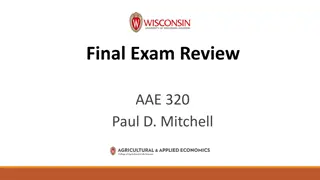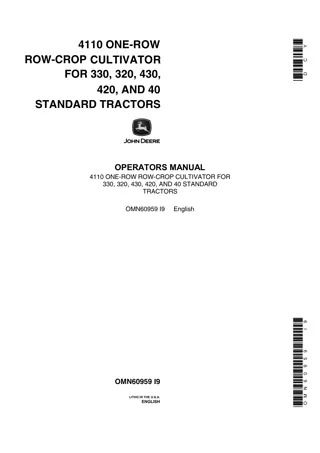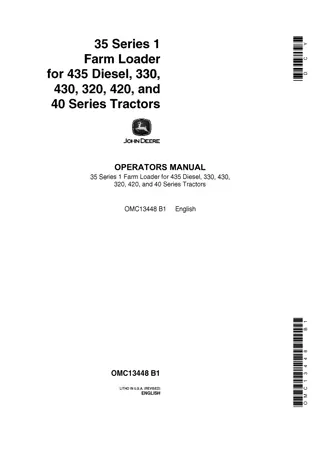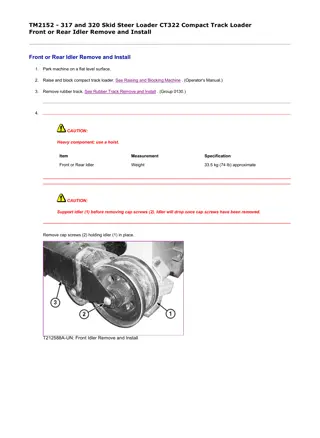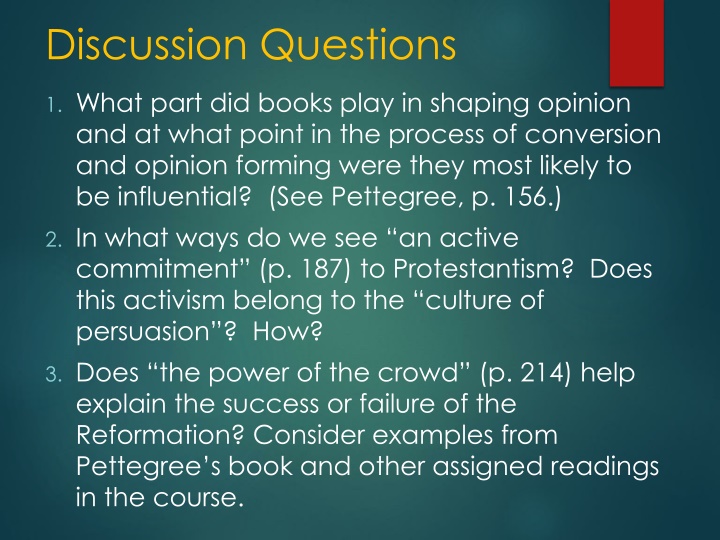
Influence of Books in the Reformation Process
Explore the pivotal role of books in shaping opinions and influencing conversions during the Reformation period, along with analyzing the power of crowds and the cultural activism associated with Protestantism. Evaluate the success and failure of the Reformation through the lens of social forces and religious identities.
Download Presentation

Please find below an Image/Link to download the presentation.
The content on the website is provided AS IS for your information and personal use only. It may not be sold, licensed, or shared on other websites without obtaining consent from the author. If you encounter any issues during the download, it is possible that the publisher has removed the file from their server.
You are allowed to download the files provided on this website for personal or commercial use, subject to the condition that they are used lawfully. All files are the property of their respective owners.
The content on the website is provided AS IS for your information and personal use only. It may not be sold, licensed, or shared on other websites without obtaining consent from the author.
E N D
Presentation Transcript
Discussion Questions 1. What part did books play in shaping opinion and at what point in the process of conversion and opinion forming were they most likely to be influential? (See Pettegree, p. 156.) 2. In what ways do we see an active commitment (p. 187) to Protestantism? Does this activism belong to the culture of persuasion ? How? 3. Does the power of the crowd (p. 214) help explain the success or failure of the Reformation? Consider examples from Pettegree s book and other assigned readings in the course.
Discussion Questions 4. Now that you have completed Pettegree s book, where do you think he belongs in the debate over the success or failure of the Reformation? 5. Pettegree's idea of new solidarities is not merely relevant to Protestantism. It is also evident in Holt s article. How does it figure in the failure of Protestantism in Dijon? 6. In evaluating the success or failure of the Reformation, can or should we separate social forces from religious identity? What does Holt s article suggest?
Reformation and the Culture of Persuasion Our purposes in reading the book: 1. to assess the effectiveness of various media to present and gain acceptance of the religious message of the Reformation 2. to supplement our investigation of the debate about the success / failure of the Reformation. Can you find connections between the book and the assigned articles and MacCulloch s Reformation? Questions to keep in mind: 1. How do we assess effectiveness? 2. Does effective presentation of the Reformation message necessarily mean acceptance of the message?
Pamphlets and Persuasion Why did people buy books? Not just to read from cover to cover. as a badge of identity as a memento as a mark of professional status to signal social aspiration as a fashion statement for reassurance through a sense of obligation, to honour someone we admire. out of idle curiosity as gifts (157)
Pamphlets and Persuasion: The Crowd Made Text Why did people buy pamphlets in the sixteenth century? (159) Those who bought large books also bought small books: true of France and Low Countries where Protestant books forbidden. pamphlet wars in 1520s: ca. 6,000 editions x 1,000 copies each = 6,000,000 copies 2,000,000 copies in Paris, 1589-90, in support of Catholic League collections of pamphlets often bundled together in printer s shop: pamphlets valuable as individual works and as ensembles
Pamphlets and Persuasion: The Crowd Made Text domestication of the literature of protest created an impression of cacophony and irresistible pressure. They were the crowd made text (162). the work of educated writers but collective dimension created the impression of an overwhelming tide, an unstoppable movement of opinion. Their force lay in the power or the appearance of collective, irresistible might (163)
Pamphlets and Persuasion: Pamphlet Moments 1518-1526 in Germany = ca. 6,000,000 copies for first time book market dominated by small books in German (not Latin) Protestants dominated book market Luther dominated but 2,500,000 copies by other authors in support of Luther before 1546 Flugschriften = pamphlets
Pamphlets and Persuasion: Pamphlet Moments Luther benefited from simplification supporters emphasized clerical corruption Ghent baker Lieven de Zomere owned at least two books by Luther a local cleric read him some of Babylonian Captivity of the Church (1520) de Zomere did not understand sola scriptura a powerful doctrine, reinforced by Luther s New Testament in German (1522) manifested in the pulpit, on stage, in the Bible itself (170)
Pamphlets and Persuasion: Pamphlet Moments pamphlet literature of the Lutheran Reformation: provided the frisson of danger, a taste of the forbidden, disapproved or controversial, without, in fact, being dangerous (170) 1560s in Northern Europe
Pamphlets and Persuasion: Proxy Evangelists vigilance re: vernacular books; rules against printing works of forbidden authors; pre- publication censorship by university France: public support for the Reformation was, from the first, rendered impossible (172) re: pulpit. discreet / disguised publications; but still dangerous rise of publication of Bibles in 1540s and 1550s: an economic lifeline for printers (175)
Pamphlets and Persuasion: Proxy Evangelists How effectively had books been able to function as proxies for evangelism in a climate of hostility and repression? (175) control of dissemination successful to a point books still proved most effective when they played a supporting role among other media of evangelical agitation (176) books help sustain faith of small secretive groups.
Pamphlets and Persuasion: Proxy Evangelists How effectively had books been able to function as proxies for evangelism in a climate of hostility and repression? (175) The proxy evangelism of clandestine literature kept the Reformation alive, but at a price, since many self-trained adepts arrived at views that could not be contained within the developing orthodoxies of the new movement (176) exile churches important re: proper formation of future leaders
Pamphlets and Persuasion: Two Tribes How do we judge the contribution of books to this vast turbulent movement of protest and religious renewal? (277) second pamphlet moment, Northern Europe, 1560s intense, prolific, printing inside France; printers used Genevan emblems to attract interest
Pamphlets and Persuasion: Two Tribes What can we say of the role, tone, and content of the printed polemic of Protestantism in this new period of opportunity? (179) print part of a broad, cross-media movement of public agitation and debate (179) intermingling of religious and political themes; in France: attack on Guise family
Pamphlets and Persuasion: Two Tribes Catholic pamphlets on counter-attack Between 1560 and 1565 the polemical battle between Catholics and Protestants was waged with an unprecedented ferocity in France. Never before in the Reformation century had two contending parties made their case to the reading public with such force, or with evident lack of mutual sympathy (182-83). Davies rules of propaganda: simplification, disfiguration, transfusion, unanimity, transfiguration
New Solidarities weakness of confessionalization paradigm: not all change imposed from above Pettegree s focus: an active commitment to a form of religion (187)
New Solidarities: Schools of Christ Bible: In this book the print culture of the sixteenth century was displayed in all its technical sophistication (191). 5,000,000 vernacular copies in the sixteenth century also in the godly home: music sermons, catechism service, communal singing: inculcated values of the new religion (193).
New Solidarities: Schools of Christ Even in the towns, of course, the most zealous instruction could not guarantee agreement among the citizens who brought their own increasingly autonomous readings to what they heard in the pulpit, or read in their books at home. Empowerment of a theologically informed laity brought its own dangers. (193-94)
New Solidarities: Battles half won French Huguenots create separate culture: dress, names for children, marriage, business practices 1572 massacres: destruction, dislocation, sense of embattlement, moral rigour of Huguenot ministers Netherlands: consistorial discipline allowed by authorities only for those who freely submitted themselves to it; two types of adherents: full confessing members and sympathizers who did not communicate England: vestiarian controversy; gentry patronage of godly preachers; but godly not separatists
New Solidarities: Godly kin & godly nation creation of Protestant community beyond local worship practice: Protestant histories, martyrologies, calendars cleansing of Catholic calendar, promotion of Protestant calendar with new days of commemoration biblical events, contemporary martyrs new commemorations could not be easily imposed from above
New Solidarities: Godly kin & godly nation Protestant identity: narrow in focus, exclusive and limited, common heritage and broad fellowship incubated at school, home, everyday commerce of sociability most potent when under threat from Catholicism
Culture of Belonging the urgent tone of conflict and call for activism best conveyed by the oral means of articulating the new teachings: by preaching and by song (212) extent of Protestant success or failure: prejudiced by gloomy reflections of the reformers themselves (213) disjunction between reformers aims and process of church building transmitting knowledge vs. culture of belonging. ;
Culture of Belonging The essentials of faith were mediated or possibly only inferred around the constant enactment of the religious life as sharing: a parish religion, a civic culture, a familial experience embracing generations past (213). In order to succeed, the Reformation had to replace institutions and associations damned by evangelical criticism with a new complex of loved, lived solidarities (213).disjunction between reformers aims and process of church building (213). ;
Culture of Belonging the importance of the crowd, the counter- community symbols: badges of belonging (215) medals, tokens woodcut as badge of identity pamphlets too, hence punishment for possession ;
Wine, Community and Reformation In evaluating the success or failure of the Reformation, can or should we separate social forces from religious identity? What does Holt s article suggest? 1. What view of the Reformation does Holt s article imply? 2. Can we safely label as Counter-Reformation the events as well as the social and cultural forces that prevented the establishment of Protestantism in Dijon? 3. The articles by Scribner, Goodale, and Holt all direct attention to social forces when considering the success or failure of the Reformation. Do you notice any similarities or differences in interpretations and methodology among the three articles?


